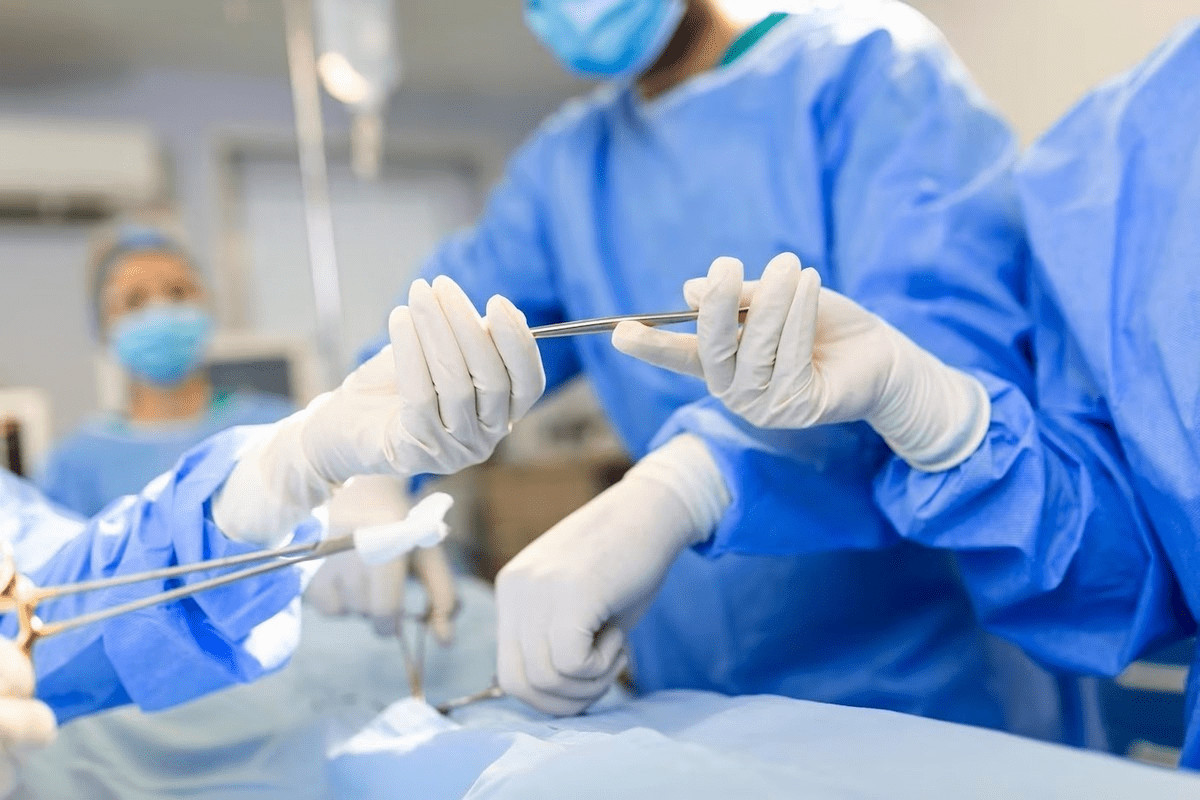Last Updated on October 31, 2025 by

Transurethral resection of the prostate (TURP) is a common treatment for BPH. This condition makes it hard to urinate because the prostate is too big. Knowing about the long-term complications helps patients make better choices.
We believe in telling patients everything they need to know. It’s important to share what might happen years later. Issues like retrograde ejaculation, urethral strictures, and erectile dysfunction can occur.
We aim to give top-notch care and support for the long haul. Our goal is to help patients understand their recovery better.
Learn about the 5 most common long term problems after TURP surgery, including dry orgasm, incontinence, and the risk of re-treatment.

Men with benign prostatic hyperplasia often turn to TURP surgery. At Liv Hospital, we offer top-notch healthcare and support for international patients.
TURP surgery, or Transurethral Resection of the Prostate, helps with urinary issues caused by an enlarged prostate. It removes extra prostate tissue blocking urine flow.
TURP surgery is done through the urethra, avoiding external cuts. A special tool removes prostate tissue pressing on the urethra and bladder.
TURP helps you pee more easily by removing prostate tissue blocking your bladder or urethra. It’s great for men with BPH, improving urine flow.
TURP surgery is the top choice for BPH treatment. It’s effective in easing urinary blockages and boosting quality of life. Thanks to tech and surgical improvements, it’s more successful than ever.
Many men see big improvements in their urinary symptoms after TURP surgery.
TURP surgery aims to ease symptoms like weak urine flow and frequent urination. It’s very effective, with most patients seeing better urine function.
Outcome | Success Rate |
Relief from Urinary Symptoms | 80-90% |
Improved Urine Flow | 85-95% |
Reduced Nocturia | 70-80% |
Keep in mind, results can vary. TURP’s success depends on BPH severity and overall health.

After TURP surgery, patients go through different healing phases. Knowing these phases helps them prepare for recovery. It also alerts them to possible long-term issues.
Right after TURP surgery, patients usually stay in the hospital for 1 to 4 days. They are watched closely for any problems and their pain is managed. It’s key for patients to follow their doctor’s advice for a smooth recovery.
In the first 6 weeks, patients slowly get back to their daily activities. Most people can get back to normal in 2 to 4 weeks. But, it might take up to 6 weeks to fully heal.
During this time, some urinary issues like needing to pee a lot or right away might happen. These symptoms should get better as time goes on.
Long-term, most patients see big improvements in their urinary problems and overall life quality. But, it’s important to know about possible long-term issues like retrograde ejaculation or urethral strictures. Regular check-ups with their healthcare provider can spot problems early.
Knowing the typical recovery timeline after TURP surgery helps patients manage their healing. It also lets them address any concerns or complications that might come up.
It’s important to know about long-term issues after TURP surgery. TURP helps with Benign Prostatic Hyperplasia (BPH) but comes with risks. We must watch out for possible long-term complications.
Complication rates for TURP surgery are between 9.0 to 9.5 percent. This shows that while most patients do well, some face complications.
Common long-term issues include ongoing urinary problems, heavy bleeding, erectile dysfunction, and incontinence. Not all patients will face these, and the chance depends on several factors.
Complication Type | Approximate Incidence Rate |
Urinary Symptoms | Variable, often reported |
Erectile Dysfunction | Around 10% |
Urinary Incontinence | Less common, varies |
Several factors can raise the risk of long-term complications after TURP. These include the patient’s health, age, prostate size, and other medical conditions.
Patients with heart or diabetes issues, or older patients with larger prostates, face higher risks. This is because their bodies might react differently to the surgery.
“Careful patient selection and preoperative evaluation are key to reducing TURP surgery complications.”
— Expert Urologist
Complications can show up at different times after TURP. Bleeding or infection might happen soon after, while erectile dysfunction or strictures might appear later.
Knowing when complications might happen helps us watch for them and act fast.
By understanding these complications and their timing, we can improve care and outcomes for TURP surgery patients.
Retrograde ejaculation is a common issue after TURP surgery, affecting many patients. It happens when semen goes back into the bladder during orgasm instead of coming out through the penis.
About 65 to 75 percent of men experience retrograde ejaculation after TURP. This is mainly because the surgery changes the area around the bladder and prostate. This change messes up the normal way semen is ejaculated.
This condition can worry many men having TURP surgery. But, the good news is that it doesn’t affect the feeling of orgasm. Men can usually feel orgasm as usual.
The effect of retrograde ejaculation on sexual satisfaction varies. Some men don’t notice much difference, except for the lack of ejaculation. Others might feel psychological effects that affect their sexual satisfaction.
For men wanting to have children, retrograde ejaculation is a big problem. But, there are ways to manage it and treatments for fertility.
Aspect | Impact of Retrograde Ejaculation |
Sexual Satisfaction | Variable; orgasm sensation remains but ejaculation is affected |
Fertility | Significantly impacted; semen does not exit through the penis |
Management Options | Available; includes medications and fertility treatments |
There are ways to manage retrograde ejaculation. Medications like pseudoephedrine or imipramine might help. For those worried about fertility, sperm retrieval for assisted reproduction is an option.
“The psychological impact of retrograde ejaculation should not be underestimated. Counseling and support can play a critical role in helping men cope with the changes they experience post-TURP surgery.”
Healthcare providers should talk about these possible complications with patients before surgery. This ensures they know what to expect and are ready for any changes.
After TURP surgery, some people may face urethral strictures. This is when the urethra narrows, leading to trouble with urinating. We’ll look at how strictures form, their symptoms, and how to treat them.
Scar tissue in the urethra causes urethral strictures. This can happen after TURP surgery. About 2.2 to 9.8 percent of patients get strictures. Knowing why they form helps us manage them better.
Signs of urethral stricture include weak urine flow and trouble starting to urinate. Severe cases can cause you to hold urine for a long time. Spotting these signs early is key to getting help.
There are many ways to treat urethral strictures, from simple to complex surgeries. The right treatment depends on how bad the stricture is and where it is.
Treatment Option | Description | Success Rate |
Dilation | A minimally invasive procedure to widen the urethra. | 40-80% |
Urethrotomy | A surgical procedure involving cutting the scar tissue. | 30-70% |
Urethroplasty | A surgical reconstruction of the urethra. | 80-90% |
We’ll choose the best treatment for each patient based on their needs and medical history.
Bladder neck contractures are a serious issue after TURP surgery. They cause the bladder neck to narrow, leading to trouble with urination. This problem affects 0.3 to 9.2 percent of patients who have TURP.
Scarring and fibrosis from TURP surgery can cause bladder neck contractures. This scarring narrows the bladder neck, blocking urine flow. Factors like how much tissue is removed, infections, and past surgeries increase the risk.
The symptoms of bladder neck contractures can be tricky to spot. They might seem like other issues, like urethral strictures. But, look out for:
To diagnose, doctors use a mix of exams, uroflowmetry, and sometimes cystoscopy. This lets them see the bladder neck directly.
There are several ways to treat bladder neck contractures. The right treatment depends on how bad the contracture is and the patient’s health.
Dealing with TURP complications can be tough. Our team is here to help. We offer full care and support to manage bladder neck contractures well, aiming for the best results for our patients.
Erectile dysfunction is a big worry for men after TURP surgery. It’s upsetting to think about not being able to get an erection after surgery. We’ll look at how common it is, why it happens, and how to tell it apart from age-related issues. We’ll also talk about what can be done to treat it.
About 10% of men face erectile dysfunction after TURP. The reasons are complex, involving damage to nerves and blood vessels near the prostate during surgery.
Telling TURP-related ED from age-related ED can be hard. But, timing and how it starts can help. TURP-related ED usually starts right after surgery. Age-related ED gets worse over time.
There are treatments for erectile dysfunction after TURP. These include medicines like PDE5 inhibitors, vacuum devices, and sometimes, surgery like penile implants. The right treatment depends on the cause, how bad it is, and what the patient wants.
Here’s a quick overview of erectile dysfunction after TURP surgery:
Aspect | Description |
Incidence Rate | Approximately 10% |
Underlying Causes | Nerve and vascular damage during surgery |
Treatment Options | PDE5 inhibitors, vacuum devices, penile implants |
Urinary incontinence is a common issue after TURP surgery. It affects many patients. This problem can be upsetting, but it’s usually temporary.
Some men face this issue right after surgery. But most regain control in 3-6 months as their muscles get stronger. Early urge incontinence hits 30 to 40 percent of patients. Late stress incontinence is rare, affecting less than 0.5 percent.
Knowing about urinary incontinence after TURP helps patients prepare for recovery. We’re here to support you. We offer care and guidance for managing long-term issues, including incontinence.
By understanding urinary incontinence after TURP, we can lessen its effects. Our aim is to provide top-notch healthcare. We focus on the unique needs of international patients having TURP surgery.
Common issues after TURP surgery include retrograde ejaculation and urethral strictures. Other problems are bladder neck contractures, erectile dysfunction, and urinary incontinence.
About 65-75% of patients experience retrograde ejaculation after TURP surgery. It’s the most common complication.
Urethral strictures can occur in 2.2% to 9.8% of patients. This risk varies based on several factors.
About 10% of patients face erectile dysfunction after TURP surgery. The exact reasons are not fully understood but may relate to pre-existing conditions.
Urinary incontinence is a possible complication. The exact incidence varies by study and patient population.
Yes, many complications can be managed or treated. This depends on the specific issue and available treatments.
Higher risks include older age, poor health, larger prostate size, and the surgical technique used.
Recovery times vary. Most patients can resume normal activities within weeks to months.
TURP surgery is a top treatment for BPH. It offers significant symptom relief and improves quality of life for most patients.
Subscribe to our e-newsletter to stay informed about the latest innovations in the world of health and exclusive offers!